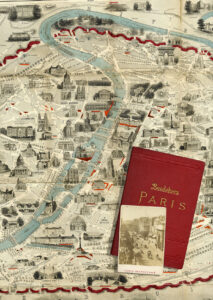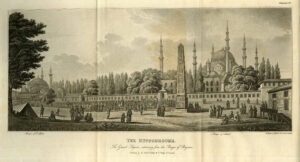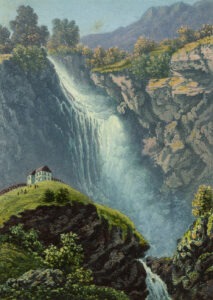Books That Take Us Lands Away: Tourism and Print Culture in the Nineteenth Century
Date:
13 March 2013 – 28 February 2014
Location: Stettinius Gallery, Alderman Library
Curated by: Theresa Goodman
 Travel was a perennial inspiration for nineteenth-century writers. Think of Pride and Prejudice, Little Dorrit, Aurora Leigh, Middlemarch, Little Women, The Portrait of a Lady, or The Marble Faun. Characters in all of these novels spend transformative time as tourists. Often, the trips in these books parallel journeys their authors had taken. For instance, Louisa May Alcott began writing Little Women after returning from a European tour similar to Amy March’s. Henry James, who wrote many novels about European tourists, began his first novel while traveling through Venice and Paris.
Travel was a perennial inspiration for nineteenth-century writers. Think of Pride and Prejudice, Little Dorrit, Aurora Leigh, Middlemarch, Little Women, The Portrait of a Lady, or The Marble Faun. Characters in all of these novels spend transformative time as tourists. Often, the trips in these books parallel journeys their authors had taken. For instance, Louisa May Alcott began writing Little Women after returning from a European tour similar to Amy March’s. Henry James, who wrote many novels about European tourists, began his first novel while traveling through Venice and Paris.
Travel, or rather tourists and their disposable income, also inspired other bookmakers. Publishers noticed the tourist market and began to fill it with guidebooks, souvenir albums, and editions of travel memoirs and novels. Tourists in their turn were influenced by the books available to them. They were inspired by fashionable writers; they relied on guidebooks; and they looked back on their journeys with the aid of purchased souvenirs.
Books That Take Us Lands Away tracks this cycle of influence between printed materials and nineteenth-century tourism, to come to a better understanding of the afterlife of the Grand Tour. The items on display from Rare Book School’s collections represent, and therefore illuminate, the stages of a typical journey—the moment of inspiration, the voyage, trips to popular monuments, souvenir shopping, and the nostalgia of the return home.

This is the frontispiece to Picturesque Promenades in and near Constantinople (London, 1820). The author claims that in this city, “every view is a picture bursting on the sight.”
The Inspiration
No traveler left home without some justification for his or her voyage. Some reasons were traditional: the Grand Tour, a trip through Continental Europe, was a standard element of an eighteenth-century British gentleman’s education. Travel accounts in this exhibition suggest what kind of education these gentlemen and their nineteenth-century imitators acquired; these accounts focus on antiquities, economics and sociology, and social engagements. The ruins of the Roman Forum fascinated classicists, while Mount Etna attracted students of geology. Other nineteenth-century voyagers traveled for business, missionary work, or even from medical necessity (some guidebooks in this show describe sea-bathing and spa treatments). But most tourism is finally about pleasure. Many nineteenth-century tourists traveled in search of beauty. One can see this attitude in travel accounts such as Picturesque Promenades in and near Constantinople, whose frontispiece is reproduced at right.
Tourists also followed the fashions set by traveling celebrities, including famous writers. Romantic poets such as Byron and Wordsworth were celebrated travelers. American authors Mark Twain, Nathaniel Hawthorne, and Washington Irving all published accounts of their European tours. Some authors even wrote what amounted to guidebooks, such as John Ruskin’s art guides for Italy. His Mornings in Florence was sold in Europe, both in small, portable copies affordable for students, and in elegant souvenir bindings. Literary characters could also be model travelers: examples include Byron’s Childe Harold and Don Juan, or Rollo, the hero of a popular children’s series. Overall, travel accounts both real and fictional help show us what encouraged travelers to leave home.
The Journey and the Destination
No traveler set off empty-handed. Guidebooks helped tourists navigate strange countries. Phrasebooks include sample questions, showing modern readers what a nineteenth-century tourist might need to ask an innkeeper or cab driver. Light reading fended off the boredom of slow carriage and train rides, and publishers marketed cheap, small-format books specifically to travelers.

This hand-colored aquatint of the Reichenbach Falls is from a viewbook titled Souvenir de Berne et ses environs (Zurich, c.1852). After seeing this waterfall, Arthur Conan Doyle chose Reichenbach as the setting for Sherlock Holmes’ final fight with Professor Moriarty
With the entire Continent open to them, British and American tourists had to be selective about their travels. Some chose destinations recommended in guidebooks like Baedeker’s or Cook’s. Some were drawn by special events like the various great exhibitions, expositions universelles, and world fairs. Others were inspired by their everyday reading material, and hunted for the scenes inhabited by their favorite characters. Fans of Rousseau’s Julie went to Switzerland; readers of Jane Eyre searched England for the “real” Thornfield Hall. Some illustrated editions of these novels include as many landscapes as character tableaux, reflecting the interest in their settings.
Tourists gathered more print material as they traveled. Events and attractions often came with pamphlets and programs: a tourist might pick up a concert program, an opera libretto, a guide to the Tower Menagerie in London. Some even traveled as connoisseurs or collectors, with the express purpose of buying rare books or new paintings.
The Recollection
Nineteenth-century tourists, lacking iPhones and video cameras, could record their experiences in journals and sketchbooks. Some publishers sold prepared albums, which included both printed illustrations of famous monuments and space for the owner’s pictures. Pictorial souvenir books abounded, ranging broadly in size, style, splendor, and price. (The image of the Reichenbach Falls above is from a book of Swiss views featured in the exhibition.) Around the middle of the nineteenth century, photographs became commercially available as souvenirs. Tourists could buy photos, books of photos, or even books of printed pictures imitating photos.
Tourists occasionally composed creative responses to their travels. Sometimes, this was as simple as describing a voyage in a letter home. They could create travel albums, or even select photographs to custom-illustrate their own copies of travel novels. When artists went on tour, the responses were more involved: this exhibition includes a case study of artistic responses to the ruins around Mount Vesuvius, centered on Edward Bulwer-Lytton’s novel The Last Days of Pompeii.
The Legacy
With the advent of new technologies during the twentieth and twenty-first centuries, the intersections between tourism and print culture have certainly changed. This exhibition closes with a selection of twenty-first-century memorabilia collected by UVA students abroad. These tickets, maps, journals, and collages reveal that we continue to rely on printed artifacts. We can print boarding passes at home, but we still accumulate tickets and ephemera. Our phones have GPS and translation apps, but we carry guidebooks for the places where the Internet stops working. We can snap digital photos and upload them to Facebook from our hotel rooms, but we keep buying postcards to send home. The print and paper artifacts in our personal souvenir collections preserve the stories and memories of our own tours.
Theresa Goodman is currently the Assistant Curator at Rare Book School. She is an alumna of the University of Virginia twice over, having received her B.A. in English and French in 2012 and her M.A. in English in 2013. Her master’s thesis focused on E. M. Forster’s treatment of travel artifacts in A Room with a View.
This exhibition is made possible by Rare Book School and The Jefferson Trust, an initiative of the UVA Alumni Association, as part of the “Why Books Matter” Exhibition Series, celebrating Rare Book School’s twentieth anniversary on Grounds.
